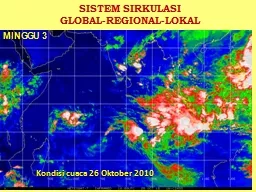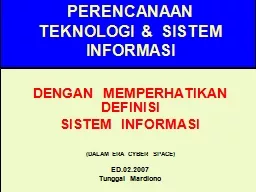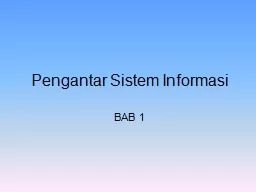PPT-SISTEM SIRKULASI GLOBAL-REGIONAL-LOKAL
Author : trish-goza | Published Date : 2018-11-04
Kondisi cuaca 26 Oktober 2010 MINGGU 3 SIRKULASI UDARA GLOBAL Sel Hardley Gerakan massa udara ini akibat perbedaan insolasi yang diterima muka bumi secara
Presentation Embed Code
Download Presentation
Download Presentation The PPT/PDF document "SISTEM SIRKULASI GLOBAL-REGIONAL-LOKAL" is the property of its rightful owner. Permission is granted to download and print the materials on this website for personal, non-commercial use only, and to display it on your personal computer provided you do not modify the materials and that you retain all copyright notices contained in the materials. By downloading content from our website, you accept the terms of this agreement.
SISTEM SIRKULASI GLOBAL-REGIONAL-LOKAL: Transcript
Kondisi cuaca 26 Oktober 2010 MINGGU 3 SIRKULASI UDARA GLOBAL Sel Hardley Gerakan massa udara ini akibat perbedaan insolasi yang diterima muka bumi secara. V. FAKULTAS . PETERNAKAN DAN PERTANIAN UNIVERSITAS DIPONEGORO . - SEMARANG. 18 – 19 NOPEMBER . 2015. “PERAN UNGGAS LOKAL . DALAM . MENDUKUNG . INDUSTRI . PERUNGGASAN NASIONAL”. OLEH :. Ir. ARDI WISUKU ADISOEROSO. Pengantar Linguistik Umum. 10 September 2012. Nadya Inda Syartanti. APAKAH BAHASA ITU?. Bahasa. Apa yg terpikirkan oleh Anda?. Bahasa.... bunga. diplomasi. militer. warna. ..... ..... Bahasa...(lanjutan). Content. The Software Engineering Discipline. Software engineering . adalah. . cabang. computer science . dengan. . prinsip. . pengembangan. system software yang . besar. . dan. . kompleks. Pengembangan. DEPARTEMEN KELAUTAN DAN PERIKANAN RI. Magister Teknologi Informasi untuk Perpustakaan. Sekolah Pasca Sarjana IPB. 2009. Disusun oleh. Dadan Syachrulramdhani – G652080135. Alfa Husna – G652080055. DENGAN MEMPERHATIKAN DEFINISI. SISTEM INFORMASI. . (DALAM ERA CYBER SPACE). ED.02.2007. Tunggal Mardiono. Tunggal M.. DENGAN MEMPERHATIKAN LINGKUNGAN YANG SELALU TERKAIT DENGAN ISTILAH-ISTILAH BERIKUT.. Ivan . Sukmayadi. 10507669. PROGRAM STUDI SISTEM INFORMASI. FAKULTAS. TEKNIK DAN ILMU KOMPUTER . UNIVERSITAS KOMPUTER INDONESIA. 2012. Latar. . belakang. Teknologi. . dan. . informasi. . merupakan. SUMBER DAYA GENETIK. SPESIFIK LOKASI. BALAI BESAR PENGKAJIAN DAN PENGEMBANGAN TEKNOLOGI PERTANIAN. 201. 8. Workshop . Evaluasi. . Pelaksanaan. . Percepatan. . Pendaftaran. . Varietas. . Lokal. Global Warming. Global warming . atau. . pemanasan. global . diartikan. . sebagai. . peningkatan. . suhu. rata-rata . bumi. .. Faktor-faktor. . penyebab. global warming. PBB . membentuk. . kelompok. APLIKASI &P. ENGUKURAN . BEBAN TUGAS. JKSS – . Jawatankuasa. . Semakan. . Sistem. Governan. . Permohonan. . Sistem. . Aplikasi. Kaedah. . Pengukuran. Beban . Tugas. Kandungan. :. Jawatankuasa. & . Sistem. . Operasi. [. Bagian. 2]. -. Pengantar. . Sistem. . Operasi. -. Yuli. . Haryanto. , . M.Kom. MODUL. SISTEM OPERASI. Modul. . Sistem. . Operasi. / . Unindra. . / . 2011. Modul. PENILAIAN KINERJA MENGGUNAKAN METODE BALANCE SCORECARD. 1. Randhi Ramadhani Rivai, . 2. Doni. Program Studi Sistem Informasi STMIK LPKIA. . 2017 . LATAR BELAKANG. IDENTIFIKASI PERMASALAHAN. HASIL PENELITIAN. operativni. . sistem. ?. Operativni. . sistem. je . kompleksan. . programski. . sistem. . sastavljen. . od. . skupa. . programa. . koji. . treba. . da. . obezbede. . lako. . i. . efikasno. PENGERTIAN AUDIO. Audio. . dalam. . sistem. . komunikasi. . bercirikan. . video. , . sinyal. . elektrik. . digunakan. . untuk. . unsur. . bunyi. . . Istilah. . ini. . juga. . biasa. . digunakan. . BAB 1. KELOMPOK 1. Gufroni. . Mahmuda. (0211 10 040). Weni. . Mulya. . Setyani. (0211 10 043). NurCahya. . Fahmi. (0211 10 062). . TUJUAN BELAJAR. - . memahami. . bagaimana. . peranti. .
Download Document
Here is the link to download the presentation.
"SISTEM SIRKULASI GLOBAL-REGIONAL-LOKAL"The content belongs to its owner. You may download and print it for personal use, without modification, and keep all copyright notices. By downloading, you agree to these terms.
Related Documents














